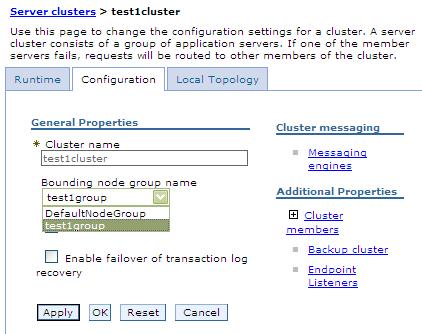Server cluster settings
Use this page to view or change the configuration of a server cluster instance, and to view the local topology of a server cluster instance.
To change the configuration and local topology of a server cluster, in the console click...
Servers | Clusters | cluster

To view runtime information, such as the state of the server cluster, click...
Servers | Clusters | cluster | Runtime tab
To display the topology of a specific cluster, click...
Servers | Clusters | cluster | Local Topology tab
If the high availability infrastructure is disabled and you require IIOP routing capabilities, click...
Servers | Clusters | cluster | Runtime tab | Export route table
...to take a snapshot of the run-time cluster routing information as viewed by the Deployment Manager, and serialize it to the file system under the cluster's configuration directory. A static route table for IIOP cluster traffic is created. You should then force a node synchronize to ensure that the file is distributed to all of the nodes in the cell.
Because the information contained in the static route table does not account for server run-time state, you should only use this option if the high availability infrastructure is disabled.
Use of a static route table preempts the use of the dynamic routing table that is contained in cluster members. After the static file is transferred to a node, whenever a cluster member residing in that node starts, it uses the static table instead of the dynamic table to handle IIOP routing. If a cluster member is running when you create the static route table, restart that cluster member to give it access to the static route table information because the table is loaded at runtime.
After the table is created, an informational message, similar to the following message, is issued that indicates the name of the file that contains the table and where that file is located:
The route table for cluster MyCluster was exported to file /home/myInstall/was/server/profiles/dmgrProfile/config/cells/MyCell/clusters/Myfile.wsrttbl
As this message illustrates, the file containing the table is placed in the config directory of the deployment manager for this cluster. You should keep a record of this location so that you can delete this file when you are ready to start using dynamic routing again.
If you use this option, statically set the ORB_LISTENER_ADDRESS port on each of the cluster members because the route table is static and the cluster members do not communicate during state changes. If this port is not assigned, the cluster members restart on different ports and the static routing information is not able to route requests to the cluster members.
Configuration tab
- Cluster name
- Specify a logical name for the cluster. The name must be unique among clusters within the containing cell.
Data type String - Bounding node group name
-
Specify the node group that bounds this cluster. All appservers that are members of a cluster must be on nodes that are members of the same node group.
A node group is a collection of WAS nodes. A node is a logical grouping of managed servers, usually on a computer system that has a distinct IP host address. All appservers that are members of a cluster must be on nodes that are members of the same node group. Nodes that are organized into a node group need enough capabilities in common to ensure that clusters formed across the nodes in the node group can host the same application in each cluster member. A node must be a member of at least one node group and can be a member of more than one node group.
Create and manage node groups by clicking System administration > Node groups in the console.
- Prefer local
-
Specify that the node scoped routing optimization is enabled or disabled. The default is enabled, which means that enterprise bean requests are routed to the client node when possible. Enabling this setting improves performance because client requests are sent to local enterprise beans.
Data type Boolean Default true - Enable failover of transaction log recovery
-
Specify that for the transaction service component, failover of the transaction log for recovery purposes is enabled or disabled. The default is disabled.
When this setting is enabled, and the transaction service properties required for peer recovery of failed appservers in a cluster are properly configured, failover recovery of the transaction log occurs if the server processing the transaction log fails. If the transaction services properties required for peer recovery of failed appservers in a cluster are not properly configured, this setting is ignored.
Runtime tab
- Cluster name
-
Specify a logical name for the cluster. The name must be unique among clusters within the containing cell.
Data type String - Prefer local
-
Specify that the node scoped routing optimization is enabled or disabled. The default is enabled, which means that enterprise bean requests are routed to the client node when possible. Enabling this setting improves performance because client requests are sent to local enterprise beans.
Data type Boolean Default true - State
-
Specify whether the cluster is stopped, starting, or running.
If all cluster members are stopped, the cluster state is stopped. After you request to start a cluster, the cluster state briefly changes to starting and each server that is a member of that cluster launches, if it is not already running. When the first member launches, the state changes to websphere.cluster.partial.start. The state remains partially started until all cluster members are running, then the state changes to running. Similarly, when stopping a cluster, the state changes to partially stopped as the first member stops and changes to stopped when all members are not running.
Data type String Range Valid values are starting, partially started, running, partially stopped, or stopped.
Related concepts
Clusters and workload management
Transactional high availability
Related tasks
Creating clusters
Configure transaction properties for peer recovery
Enabling static routing for a cluster
Related Reference
Backup cluster settingsCluster topology
Server cluster collection